© 2024 ALLCITY Network Inc.
All rights reserved.

Two years ago, the Colorado Avalanche were in disarray. They were in the middle of a season in which they would go on to lose 60 games and register just 48 points in the standings, a number so shockingly low that it will be surpassed in the next few weeks by all 31 NHL teams this season.
The longtime face of their franchise quietly requested a trade and was badly hoping to be moved before the trade deadline. As rumors swirled around a team so bad they couldn’t even manage to be much of a seller at league’s midseason auction house, another player found his name in the rumor mill: the captain of the rapidly sinking ship.
“I think the message from my side of things the whole season was pretty consistent the whole year and that was to be part of the solution,” Gabe Landeskog said. “I wanted to be here, I wanted to figure this thing out and to get back to being a playoff team and a contending team. That was really my main message all along. It wasn’t anything dramatic, it wasn’t anything crazy. That was where I stood all along. Rumors or not, I always wanted to be here, I still want to be here, and I want to be here for a long time. That mindset hasn’t changed and I think when you’re going through a tough stretch as a team, individually, or both, there are two ways to go about it: either look elsewhere and find other situations or dig in and realize how fortunate you are to be in a certain position and dig in. The latter is definitely what I did.”
His approach made it clear he wasn’t interested in joining Matt Duchene on the outbound train headed for anywhere. Colorado has become part of Landeskog’s identity not only as a player but as a person.
“This has definitely come to be my home,” Landeskog told BSN Denver. “Obviously, this is my eighth season so I’m very comfortable with this city, this organization, and this group of people. I think during that season, as tough as it was, we kept believing we weren’t that far off. As crazy as that sounds because we had 48 points and 22 wins that whole season, we believed that we were way better than we had shown. Injuries and what not, and you can point to certain things if you want, but that was the main belief in here. With guys that were going to be here for a longer time, it was ‘we’re underperforming and we’re not going to be bad for a long time. We’re going to get better.’ That’s been our main belief with a bunch of these guys. It was quiet conversations that were being had. At the end of the day, I love the guys, I love the city, the organization, the fans, and everything around this place. At the end of the day, it’s a business. Had they chosen to trade me, that would have been it, but for me, my mindset was that as long as I’m here I’m going to do everything I can to help this team win.”
Part of the quiet confidence Landeskog found was instilled, in part by his rookie head coach, Jared Bednar. Things got off to a rocky start as Landeskog and Bednar had a very limited window to get familiar with one another after Patrick Roy unceremoniously left the organization in August before the open of camps in September. That left Bednar with a staff hired by Roy and a captain he had to get to know on the fly. As everyone saw, there were certainly growing pains.
“The 48-point year was a really tough year,” Bednar said in his typical understated fashion. “You come in as a coach and you’re trying to get to know everyone and touch base with Landy over the summer and coming in that year there was some excitement around the season and things kind of took a turn for us. We fell out of the playoffs pretty quickly that season. The focus kind of became our habits, our outlook on the rest of the season and what we were going to try to improve that we could take forward to the next year, what we could build on from that year and it was based for me around our young stars. I spent a lot of time with Landy and MacK that year. It was a frustrating year for them, it was a frustrating year for me but I think some of the dialogue and some of the hope and optimism about what was going to come the next year and the start of the rebuild was where we found common ground and we just kept working towards a common goal. What Landy does is he’s a real consistent guy, his approach to the game. He puts losses and wins behind him pretty quickly and kind of resets every day coming to the rink and I kind of have the same attitude and mentality. I think handing the leadership over truly to Landy, MacK, Mikko, Tyson Barrie, Erik Johnson at the start of my second year was the key. While some of those guys were wearing letters before, there was always a contingent of older players in the room that still had big voices and had been around, and rightly so had earned a lot of respect. To have those young leaders start mentoring all the kids coming in with the rebuild and I think it helped our young stars look outside their game and find ways to lead and help mentor our younger players and take on a bigger leadership role. It’s made them better players and better leaders over the last couple years.”
Those big voices were in the form of a handful of veterans such as Jarome Iginla and Francois Beauchemin, players who had accomplished so much and earned all the respect in the world during their productive careers. They weren’t the future, however, and their voices, among others, proved stifling over time as Landeskog struggled to find his footing as a younger, more unestablished player put in the ultimate leadership role.
“You learn a lot through a season like that, not only as a group but about yourself, how to handle yourself in certain situations and what works and what doesn’t,” Landeskog said. “What I did realize is that you’ve got to take charge and sometimes when the team is rolling you don’t have to say much but when things aren’t you’ve got to step up and make sure guys know what is expected of them and what’s acceptable and what’s not. I think it’s easier to do those things with time. With experience comes that stronger voice in the dressing room and with us having a younger group it can be easier to talk to guys rather than when I came in as a 19-year old and there’s guys that are twice my age and it’s hard to talk to certain players because they’ve got so much more experience and you’re shy and don’t want to step on anybody’s toes. I think just being more comfortable in my shoes and my position is really what’s been happening over the last few years.”
When Landeskog entered his second season, the Avalanche and incumbent captain Milan Hejduk passed on the captaincy to a 19-year-old Landeskog, making him the youngest captain in NHL history at the time (Connor McDavid would later take this mantle). Tyson Barrie, who had played his first 10 NHL games during Landeskog’s rookie season in 2011-12, has seen it all as he has spent his entire Avalanche career following Landeskog’s lead.
“Honestly, one of the craziest things about Landy is that when he came into the league he was already so poised and such a good leader,” Barrie said. “I think that’s obviously why they gave him the ‘C’ after his first year. The one thing about Landy is that he doesn’t change. He’s always so level-headed and such a nice person and such a lead by example kind of guy.”
That consistency from day to day has been a hallmark of Landeskog’s personality, even as he has evolved over the course of his career. As they’ve experienced the highs of winning a Central Division together to surviving the 48-point fiasco and subsequent roster purge, Barrie has seen his captain grow up and set the tone for a franchise that hopes to be coming out of its decade-long slumber to re-emerge as a Stanley Cup contender in the near future.
“When something needs to be said, he stands up and says it,” Barrie said. “He’s a vocal guy in the room now and maybe that was something that was a little uncomfortable for him early on but he’s gotten better at. He’s always very well-spoken and knows how to get the most out of guys but at the end of the day, you watch him play and he’s playing the right way every night whether he’s feeling it or not. You can always count on him being the hardest working guy on the ice, finishing his checks, first guy on the forecheck, doing the systems right, blocking shots, whatever it is. So he’s just always straight ahead and we follow him.”
Learning when to pick his spots and be vocal has been a large part of his transformation the last couple of seasons and that experience has made him a better, more effective captain in the long run.
“He’s not overly vocal,” newcomer Ian Cole said. “He’s not incessantly talking to the point where you’re like ‘All right bud, take it easy.’ He talks when something needs to be said, he has no problem getting up and speaking in front of the team and telling us we’re playing like crap, that all of us are playing like crap. But if you watch him, he goes out and leads by example every night, too. He checks every single box for what you want in a captain. It’s an honor to play with him.”
Coming from a guy who has spent his career playing under the leadership of well-respected captains such as David Backes and Sidney Crosby, that Cole has taken such a shine to Landeskog speaks volumes of both the player and person leading the Avalanche.
“I’ve been pretty fortunate to have some great captains,” Cole admitted. “He’s certainly right up there with them and in my mind equal to them. He’s obviously a heck of a hockey player and on top of the leadership is off the charts. He certainly sets a great tone, certainly for younger guys for sure.”
As a tone-setter for not only the team but the organization as a whole, Landeskog shoulders just as heavy a burden off the ice as on it. It’s not something that goes unnoticed by his teammates, old and new.
“He sets the tone as far as work ethic goes for sure,” Cole said. “In the weight room, out of the weight room. He’s always talking tactics and strategies, literally in my mind is one of the guys on the team who would be a great coach afterward, which is huge as far as communicating with younger guys and making sure everyone is on the same page not only with the energy we want to play with but the thought processes you want to have on the ice. He’s so smart and it’s a real treat to be on a team like that.”
Even when things have gone south, like in the last two months, Landeskog keeps his cool and isn’t about getting too high or low despite what the results might be. It is a message that is well-received in a still-young and impressionable locker room.
“I just think what’s so cool about him is he’s so level-headed,” Barrie said. “You would never know if he’s having a good day or a bad day. He’s just a rock in here. You can always count on him to be positive. He’s an unbelievable captain and the leader of this team.”
That level-headed approach is an extension of the message being sent by Bednar and the coaching staff. They aren’t interested in dwelling on what has happened in the past and are focused just on getting the job done on any given day. It’s an approach from their captain that makes the head coach’s job that much easier as they remain on the same page.
“[Landeksog is] not just striving to be the best player on the team, but to be the captain of the team, he’s not just worried about his game but the games of everyone around him,” Bednar said. “He does everything he possibly can to help his teammates, linemates, making sure our team is focused, our message as a coaching staff is sent to the team and reinforced by the players in the room. If he thinks something is important, we have a relationship where he will come into my office and ‘Hey, listen, don’t forget to talk about this’ because they pick up on things as players that are concerns and they bring them up and we address them as a coaching staff and help reinforce any message that he wants sent as well. It’s a two-way street there and he’s really grown to be a real solid leader who leads by example every night.”
While Landeskog the leader has undoubtedly taken steps forward, he wouldn’t be getting the recognition he is without having an exceptional season on the ice, too. He’s already surpassed his previous career-high of goals (26) in a season as he potted 28 heading into his first All-Star Game (he added another four goals in the games over the weekend). As the third banana on a line of superstars next to Nathan MacKinnon and Mikko Rantanen, both of whom have spent substantial time in the league’s top five in scoring, Landeskog was easier to overlook last year when the line originally was put together. Not anymore.
“That line is just playing so well,” Barrie said. “They’ve got such great chemistry and Landy is helping drive that by being physical. He seems to be tipping everything and when he does get chances he’s scoring everything. It’s great to see and he’s a guy who works incredibly hard on the game.”
The reward from Landeskog’s hard work has frequently come in the form of deflection goals while parked in front of the net. Even when he’s not tipping pucks being blasted his direction by his trigger-happy teammates, he’s taking away the sightlines for opposing goaltenders by making himself as big and effective a screener as possible.
“He’s always in front of the net,” Cole said. “The goalies now are so good so if there’s no traffic and goalies can see the shots, they’re not going to go in from the point. Him going to the front of the net, the way he can tip pucks, how strong he plays, how smart he is. He is very much the well-rounded, great at everything captain that everyone can rely on. Everyone knows he’s going to step up when big moments come.”
Those “big moments” Cole talks about have been in the form of Landeskog’s league-leading eight game-winning goals. That line together has been quite clutch as they’ve helped the Avalanche become one of the league’s most potent offenses in the third period.
“I think they all complement one another,” Bednar explained. “MacKinnon and Rantanen are the players they are because of a lot of the things that Landy does on that line and vice versa. I think they rely heavily on one another. I think part of what makes that line so good is their hunger and desire to be good as individuals as well as hunger and desire for our team to be a really good team and to build to be a championship team. They put a lot of that weight on their shoulders and it drives them to be consistent. Also, they hold each other accountable and expect to be really good every night and they work hard to be good every night. If one player is struggling, he’ll hear it from the other two so there’s that added intensity to be good for one another. That’s part of it, too. I look at Landy and I think over the course of the years I’ve been here he’s got a clear identity in the way he needs to play.
My first year and even at times last year he gets a little too cute at times but I think he’s built his game into what’s truly a power forward game. He gives up the puck and he goes to the right areas to score. The confidence he has in MacK and Mikko to be able to make plays allows him to get there. He knows where the puck is going to end up and that’s the net and he gets there and that’s what he brings to that line. He’s a consistent net presence and he goes to those areas to score goals. He’ll pay the price to get there and he’ll pay the price to stay there. He’s got enough skill in those areas when pucks get there he finds a way to rebound or tip them or screen the goalie, whatever the case may be. He’s also still able to make plays away from the net. He also brings an element of the defensive side of things. He’s really in tune with the way the other guys play and he covers a lot for those guys defensively. Meaning he ends up being the first back in the zone a lot helping our team breakout, plays goal line to goal line as a winger because a lot of times MacK and Mikko have the puck in the offensive zone or deep in the zone and he has to be able to do that. He’s really consistent in that and is another big help for that line just getting in and out of the zone.”
As Landeskog has produced 54 points in his first 50 games, he has 32 games remaining this season to surpass the 65-point season he produced in the 2013-14 campaign when everything went right in Colorado’s surprise run to a division title. The quality and success of his linemates have created an atmosphere where coming to work every day is likely to be a rewarding experience.
“It’s exciting,” Landeskog said with his trademark smile spreading across his face. “I think what drives us is our work ethic and the pressure we put on ourselves to succeed and together we kind of push one another and we want to be that driving line for our team. We want to be offensive guys that contribute every single night. I think that’s what has been really exciting is that we continue to have conversations about how to get better as a line and within that comes the individual stats.”
While the offensive explosion from Landeskog has been an impressive onslaught against helpless goaltenders and witless punk defenders, it’s his all-around game that has also taken a noticeable leap into a potentially elite class of player. When the PHWA did their midseason awards balloting, the usual suspects found their way to the top of the ballots as Patrice Bergeron, Aleksander Barkov, and Mark Stone finished in the top three spots, respectively.
My ballot included Landeskog in my top three as he has made a steady and impressive case for consideration as one of the league’s top defensive forwards. Don’t just take my word for it, though. Let’s get fancy.
Here are some heat maps that show individual shot impacts from players. Keep in mind you want the defensive numbers to be negative. The more negative the number, the better the defensive impact a player has.
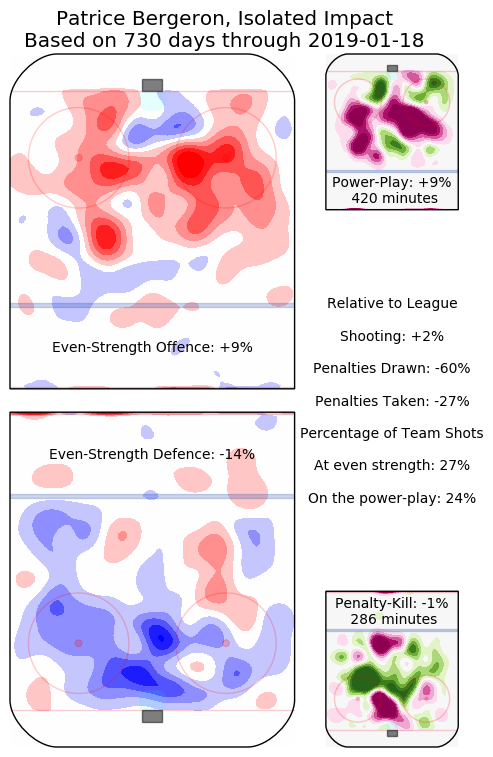
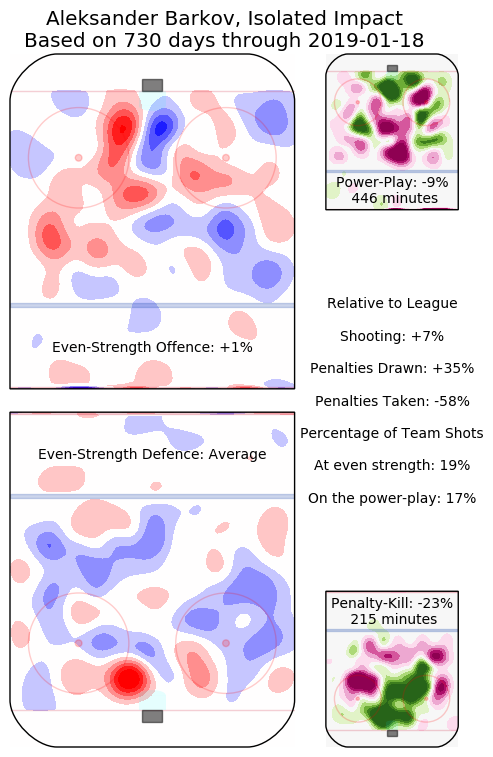
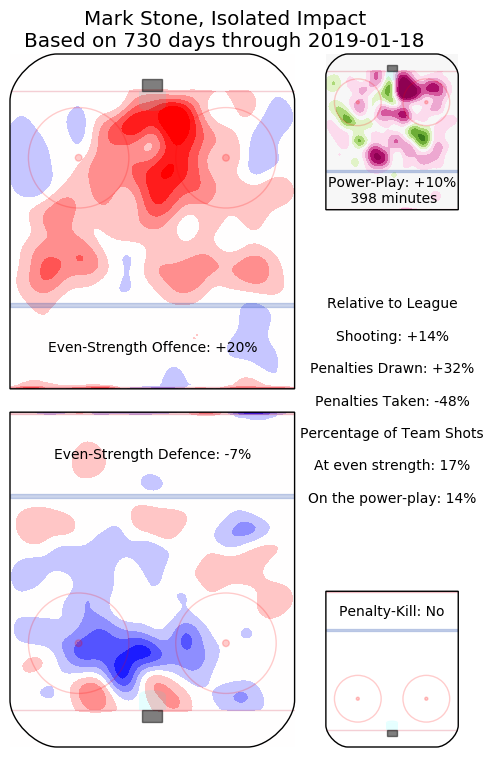
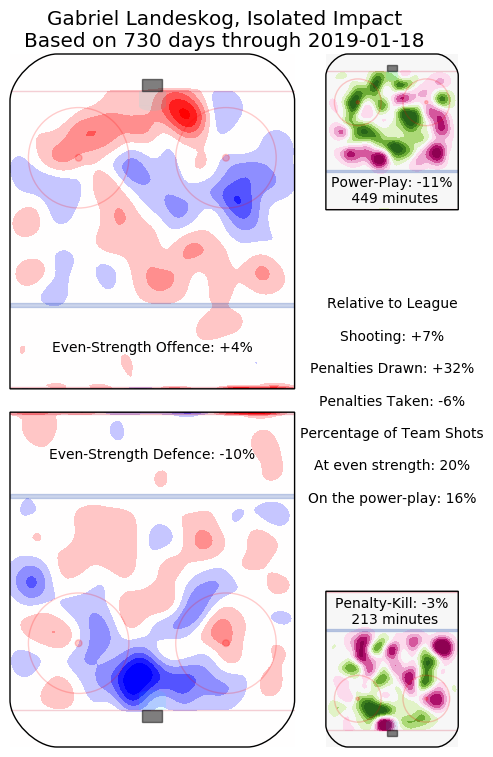
Looking at these heat maps, you can see that Landeskog has had a truly elite defensive impact. You want the darkest blue area to be right in front of the net, which is where Landeskog’s bluest bubbles come. That means the shot prevention with him on the ice is at its highest in the highest-danger area of the ice, a very good indicator of an excellent defensive forward.
We can also see that Bergeron’s hype is more than justified and Barkov’s impact at even strength is lacking pretty significantly. Barkov’s impact on the penalty kill, however, is truly exceptional while Bergeron and Landeskog’s impacts on the PK are solid but not elite. Stone doesn’t even play the PK so it’s clear the hype train on Stone’s legitimacy as a top-flight defensive forward is lacking a key factor.
Let’s dig into some more fancy stats to see how these guys shake out. For the sake of easier comparison, I have the two centers, Bergeron and Barkov, together with the two wingers aligned in the same graphic.
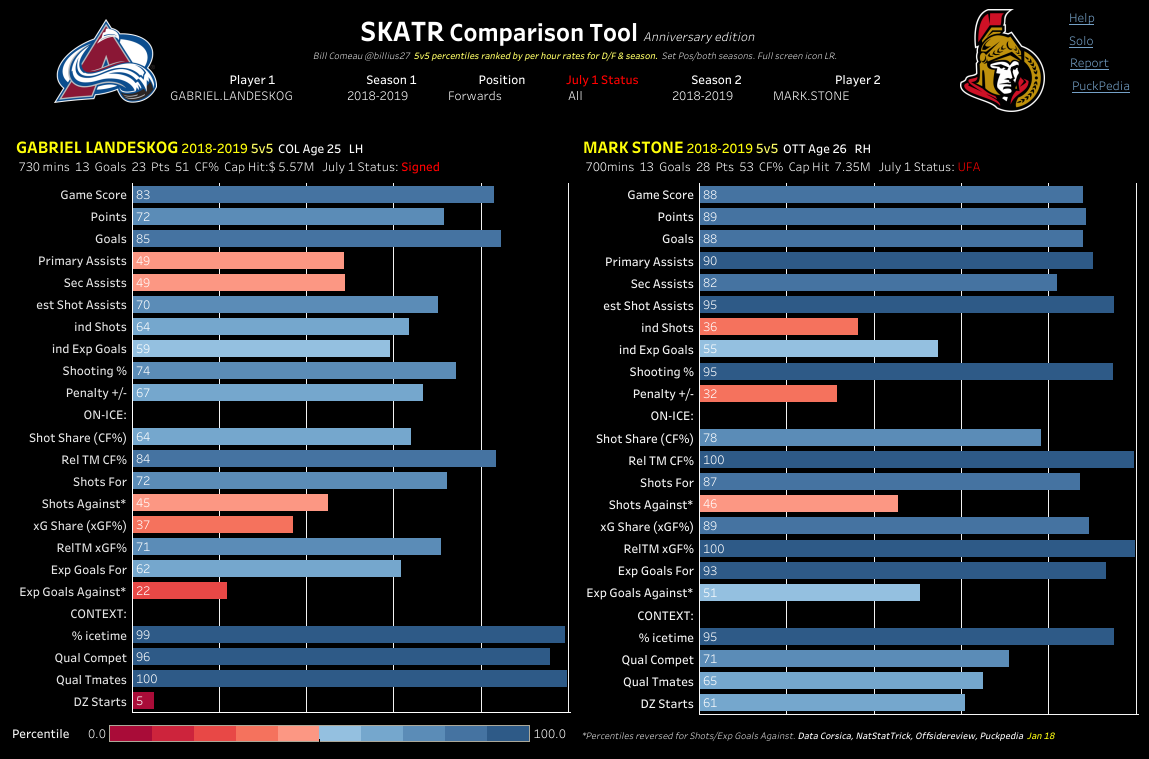
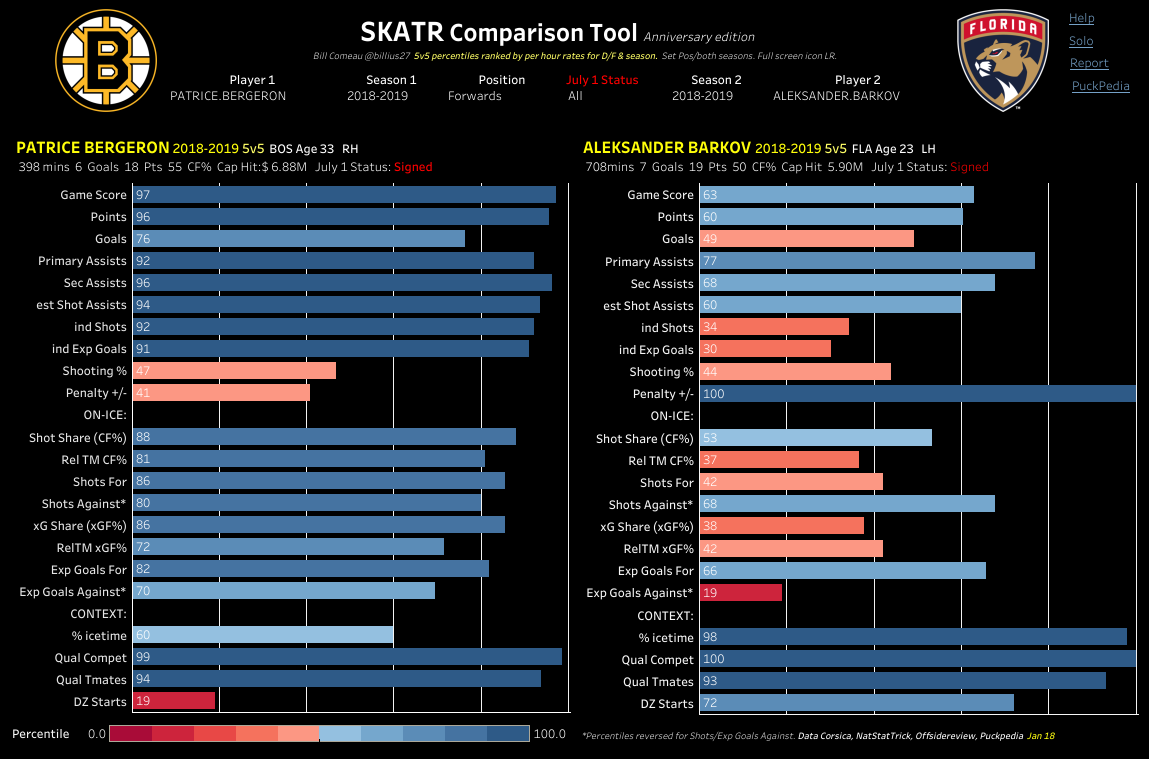
Again, Bergeron shows he is absolutely worthy of his hype as one of the league’s premier all-around forwards. These charts also show Stone’s worthiness in a way the heat maps struggled to. Landeskog’s extremely heavy offensive deployment is a consideration here though not a major one as he holds up just fine. It’s Barkov that appears to be overrated significantly and would appear to have the weakest case of being in this group.
This kind of two-way excellence from Landeskog gives Bednar one of the league’s most versatile and valuable chess pieces to play with.
“I do see him as that type of player,” Bednar said of Landeskog as a Selke-worthy candidate. “With the production on the offensive side, it would be easy to overlook what he does for our team defensively. I believe that your best players, your highest point-producers, they also have to be really good defensive players otherwise they can’t play against other team’s top lines. I’ve got a lot of faith in those guys defensively otherwise they wouldn’t be out there in all of the five versus six scenarios at the end of games where the other teams pull their goalie. Landy leads the charge in that way.”
Another area that separates Landeskog from Stone as the premier defensive winger in the NHL, at least in my opinion, is Landeskog’s excellence in the faceoff circle. While Stone has taken just 51 faceoffs, largely the result of a teammate getting tossed from the dot, he’s won just 49% of those draws. Landeskog, on the other hand, has taken a whopping 472 faceoffs already this season. While that won’t be among the league leaders in draws taken, of the 96 players with at least 400 draws taken this year, Landeskog is the only full-time wing on the list and his win rate of 52.3% puts him at 40th on that list. With MacKinnon the 95th player on that list (only Evgeny Kuznetsov is worse than MacKinnon), Bednar has begun using Landeskog not only on his strong side but his backhand side as well, a major rarity in the NHL.
“It’s an area of our game we have to improve on but generally when you look at our faceoffs in games oftentimes Landy mostly takes them on the left side,” Bednar said. “Because he’s always on his strong side taking faceoffs, he tends to be one of our best guys. I don’t have to, in key situations, put out another centerman with MacK or Mikko or with MacK and Landy because I know I’ve got Landy in those situations. We do use him in the offensive zone in a couple different scenarios on the right. Landy is a nice guy to have in there. He puts in a lot of work with our centermen after practice taking draws, which most wingers don’t. We’ve seen some improvements from some of our guys but Landy is a guy that’s worked really hard at it over the last couple of years and it’s starting to show in the games.”
Landeskog also frequently will rotate into the center role on the defensive side of the ice, allowing MacKinnon and his speed to look for opportunities to chip pucks past flat-footed defenders and use his world-class speed to create odd-man rush opportunities. This leaves Landeskog doing the heavy lifting in his own zone on top of playing the muck and grind role on offense.
“It’s definitely something I enjoy and take pride in,” Landeskog said. “It’s not what is going to write all the headlines but I think we all rotate and switch positions, sometimes a little too much and gets us all a little confused. I think making the reads is what makes us tough to play against. Unpredictable to the opponents and where the pressure is going to come from but as long as we know we take pride in our defense, we’ll get a chance to play offense. My role is something I take pride in and want to do to the best of my abilities and a lot of our d-zone coverage and faceoffs is something expected for all of us. It may be unusual for a winger to take a lot of faceoffs but I figure I can take them on my strong side and Nate can take them on his and we can win more draws like that.”
All things considered, it’s clear Landeskog is more than deserving of being in the discussion for the Selke Trophy today. If he keeps up his elite two-way performance, the rest of the hockey writers around the country will need to pay a bit more attention to give Landeskog his proper due come NHL Awards time in Las Vegas this June.
Before we get there, though, a season remains to be played. While the Avalanche will begin the unofficial second half of their season against Vancouver on Saturday night in a playoff spot, their hold has been tenuous at best as they’ve allowed the teams behind them to catch up and make a real race of it in a weaker-than-expected Western Conference. With the team struggling badly since the beginning of December, Landeskog again turns to that 48-point season for inspiration on how to avoid another epic collapse of a season.
“There are similarities in not finding ways to win, whether it be not getting that key power-play goal or key stop on the PK when we need it or a big save or whatever,” he said. “Those are things you need as a group and you need everybody together to make that happen. I also think it needs to be said that this is a completely different group than we were in 16-17. Back then we were a fragile group and I’m not going to say immature because we weren’t. We wanted to win, we wanted to work, and we did all those things but it snowballed in some ways we didn’t expect. We’re a completely different group today and I think it’s just a matter of time before we get out of this.”
Comments
Share your thoughts
Join the conversation



